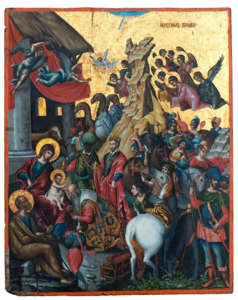| Virgin of the Burning Bush | |
|---|---|
| Greek: Η Καιόμενη Βάτος, Italian: Madonna Roveto Ardente | |
 | |
| Artist | Michael Damaskinos |
| Year | c. 1586-1591 |
| Medium | tempera on wood |
| Subject | Moses, Virgin Mary, Child Jesus, John of Damascus, and Saint Catherine with the Burning Bush. |
| Dimensions | 111 cm× 89 cm(43.7 in× 34.4 in) |
| Location | Monastery of Agia Aikaterini, Heraklion, Crete |
| Owner | Collection of Saint Catherine's Monastery Mount Sinai, Egypt |
| Website | Official Website |
The Virgin of the Burning Bush was a painting made of egg tempera and gold leaf on a wood panel. The portable icon was signed by Greek painter Michael Damaskinos. Damaskinos has over 100 known works. He was a distinguished member of the Cretan school of painting. He was from Crete. His contemporaries included Georgios Klontzas and El Greco. Damaskinos spent over twenty years traveling all over Italy. He spent a significant time in Venice. He adopted Italian artistic mannerisms which he applied to his paintings. [1]
Contents
Moses was a biblical figure who received Tablets of Stone inscribed with the Ten Commandments in Mount Sinai, Egypt as written in the Book of Exodus. In the biblical narrative, Moses was also appointed by Yahweh to lead the Israelites out of Egypt and into Canaan at the Burning Bush. Both themes are an integral part of Damaskinos's work. His painting is a rare depiction of the Virgin and Child with Moses. The painting served as an inspiration to Ieremias Palladas's painting of Saint Catherine. Palladas features some of Damaskinos's work in the background of his painting of the Egyptian martyr. Both works are a tribute to Catherine of Alexandria and Mount Sinai, Egypt. The Virgin of the Burning Bush is now in the Monastery of Agia Aikaterini in Heraklion, Crete. [2] [3] [4] [5]
